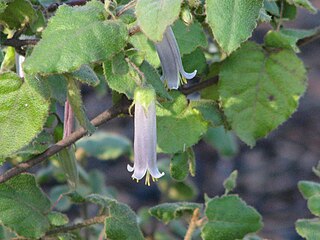
Correa aemula, commonly known as the hairy correa, is a species of shrub that is endemic to south-eastern Australia. It has broadly heart-shaped leaves arranged in opposite pairs, green or greyish green, pendent flowers arranged singly or in pairs and ageing to mauve-purple.
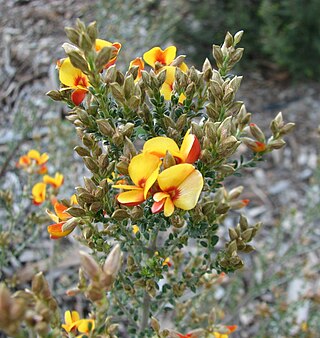
Mirbelia oxylobioides, commonly known as mountain mirbelia or sandstone bushpea, is a species of flowering plant in the family Fabaceae and is endemic to south-eastern Australia. It is a low-lying or erect shrub with narrowly elliptic to egg-shaped leaves and orange-yellow and reddish-purple flowers arranged near the end of the branches.

Leionema elatius, commonly known as tall phebalium, is a shrub species that is endemic to New South Wales and Queensland in Australia. It has glossy green, variably-shaped leaves and clusters of white-lemon flowers in spring.
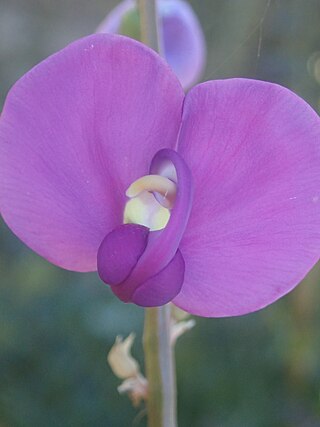
Swainsona procumbens, commonly known as Broughton pea or swamp pea is a species of flowering plant in the pea family (Fabaceae), and is native to Australia. It is a spreading or ascending perennial shrub-like herb with imparipinnate leaves with 15 to 25 linear to narrowly lance-shaped leaflets with the narrower end towards the base, and racemes of 2 to 12 purple or mauve to pink flowers.

Rhadinothamnus euphemiae, is a slender, small, upright shrub with needle-shaped branchlets thickly covered with silvery scales and tubular greenish-purple tubular flowers throughout the year. It is endemic to the south coast of Western Australia.
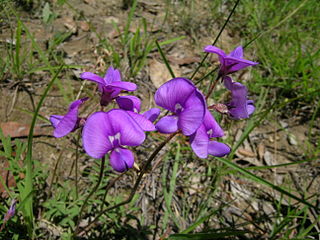
Swainsona monticola, commonly known as notched Swainson-pea, is a flowering plant in the pea family Fabaceae and grows in New South Wales and the Australian Capital Territory. It is an upright or sprawling perennial with fern-like leaves and purple pea flowers.
Stenanthemum complicatum is a species of flowering plant in the family Rhamnaceae and is endemic to the southwest of Western Australia. It is a woody, erect or straggling shrub with densely hairy young stems, broadly egg-shaped leaves and densely woolly-hairy heads of tube-shaped flowers.

Solanum nemophilum, is a flowering plant in the family Solanaceae and grows in New South Wales and Queensland. It has purple flowers and is densely covered with star-shaped hairs.

Swainsona colutoides, commonly known as bladder senna or bladder vetch, is a species of flowering plant in the family Fabaceae and is endemic to arid areas of Australia. It is an erect annual, shrub-like herb, with imparipinnate leaves usually with up to 13 to 17 egg-shaped leaflets with the narrower end towards the base, and racemes of 10 to 20 purple flowers.

Swainsona maccullochiana, commonly known as Ashburton pea, is a species of flowering plant in the family Fabaceae. It is an upright annual with purple-reddish, pink or bluish pea-like flowers from spring to summer and is endemic to Western Australia.
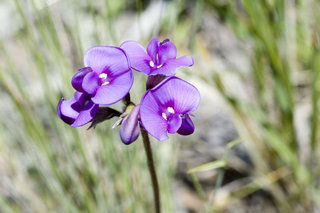
Swainsona sericea commonly known as silky Swainson-pea or silky pea, is a flowering plant in the family Fabaceae. It is a small perennial with greyish-green leaves, purple flowers and grows in New South Wales, Victoria and South Australia.
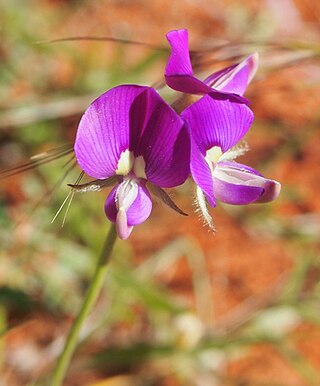
Swainsona phacoides commonly known as dwarf Swainson-pea or lilac Darling pea, is a flowering plant in the family Fabaceae, and is native to all mainland states of Australia and the Northern Territory. It is a prostrate or ascending perennial herb with imparipinnate leaves usually with 5 to 13 elliptic leaflets tapered at both ends, and racemes of usually 7 4 usually pale to dark reddish-purple.

Swainsona swainsonioides commonly known as downy Swainson-pea or downy Darling pea,is a flowering plant in the family Fabaceae. It is a small perennial herb with purple flowers and grows in eastern states of Australia.

Swainsona beasleyana is a species of flowering plant in the family Fabaceae and is endemic to inland areas of Western Australia. It is a low-lying perennial herb with imparipinnate leaves usually with 15 to 19 egg-shaped leaflets with the narrower end towards the base, and racemes of 3 to 8 pale or dark purple flowers.
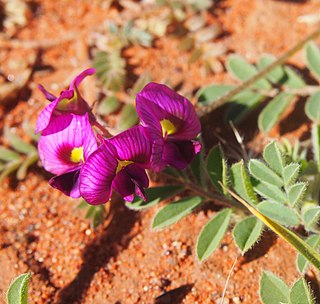
Swainsona burkei is a species of flowering plant in the family Fabaceae and is endemic to northern Australia. It is a prostrate or perennial subshrub with imparipinnate leaves usually with 5 to 11 oblong to narrowly egg-shaped leaflets, and racemes of 5 to 10 purple flowers.
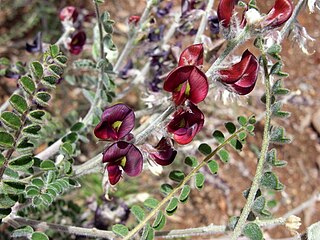
Swainsona burkittii, commonly known as woolly Darling pea, is a species of flowering plant in the family Fabaceae and is endemic to inland Australia. It is an erect or low-lying perennial with imparipinnate leaves usually with 15 to 30 egg-shaped to more or less circular leaflets, and racemes of up to fifty dark reddish-purple flowers.

Swainsona campylantha, commonly known as Gilgai Darling pea, is a species of flowering plant in the family Fabaceae and is endemic to inland areas of Australia. It is a low-growing perennial with imparipinnate leaves usually with up to 7 narrowly lance-shaped to narrowly elliptic leaflets, and racemes of 2 to 10 pink to purple flowers.
Swainsona luteola is a species of flowering plant in the family Fabaceae and is endemic to the eastern Australia. It is a prostrate or low-lying to semi-erect perennial with imparipinnate leaves with usually 3 to 17 narrowly elliptic leaflets, and racemes of 5 to 15 purple, sometimes yellow flowers.

Xanthosia singuliflora is a species of flowering plant the family Apiaceae and is endemic to the south-west of Western Australia. It is a tufted perennial herb with oblong to wedge-shaped leaves and sessile greenish-yellow flowers with 3 or 4 narrow bracts at the base.
Swainsona plagiotropis, commonly known as red swainsona-pea is a species of flowering plant in the family Fabaceae and is endemic to eastern continental Australia. It is a prostrate or ascending perennial herb with imparipinnate leaves with 13 to 25 narrowly egg-shaped or narrowly lance-shaped leaflets and racemes of 2 to 5 reddish-purple flowers.

















